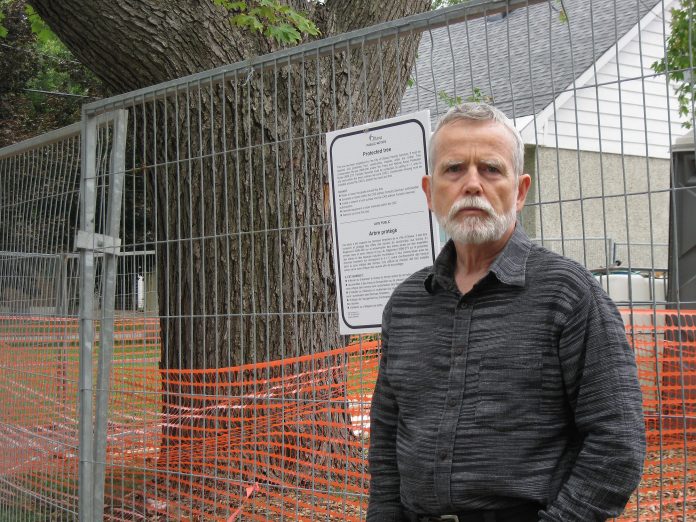By Denise Deby –
Community groups are calling for better protection of Ottawa’s trees after a mature black walnut tree was cut down in a Champlain Park backyard. The tree, which Daniel Avenue residents estimate at 65 years old and to be more than 45 feet high, was removed in mid-September after it was damaged during excavation on an adjacent property.
Big Trees of Kitchissippi, a group formed last year by members of community associations in Westboro, Wellington Village, Champlain Park, Westboro Beach and the Civic Hospital neighbourhood, says the incident shows the city needs to consider trees on residential sites and neighbouring yards when reviewing applications for demolition or infill. They also say the city needs to enforce its bylaws that protect trees from being destroyed.
Under the Urban Tree Conservation Bylaw, developers or homeowners require a permit before removing large or distinctive trees on private land. The Trees and Natural Areas Protection Bylaw requires developers to protect trees on city property.
Daniel Buckles, who lives near the construction site on Daniel Avenue, says he contacted city staff after noticing equipment close to a city-owned maple tree and the black walnut next door. After excavation began, a fence and sign went up around the maple tree indicating it was protected – “a positive step,” says Buckles – but the black walnut was subsequently cut down.

City staff say that after discussions with the tree’s owner and the developer, they issued a permit allowing the black walnut tree, which had been damaged during excavation, to be removed. Tree owner Jon Bartlett says an arborist who assessed the tree advised that it wouldn’t survive for long.
“Our tree was irreparably damaged before an arborist came into the picture, which is not the way the process is supposed to work,” explained Bartlett by email. “We were disappointed that the city doesn’t seem to enforce their own bylaws, or have some measures by which distinct trees would be taken into consideration when building permits were issued.”
Buckles, who is also an animator with the Champlain Oaks Project, says the tree’s removal is a loss to the homeowners and the neighbourhood. He and other Big Trees of Kitchissippi members point to this as one more example of area trees being destroyed during intensification.
City staff say that in the Daniel Avenue case and others, they’re taking measures to make tree preservation a priority.
“Staff work with both the community, neighbours, and the developers to educate on building design to preserve root space, methods for tree protection during construction and education and awareness on the benefits of mature trees,” explains David Barkley, the city’s manager of forestry services, by email.
“Our goal has to be to stop this from happening again,” says Councillor Jeff Leiper. He says the city’s Urban Forest Management Plan, introduced September 23, is an opportunity to encourage the Committee of Adjustment to include trees on site plans and identify barriers to enforcing the bylaws. He adds that the city’s forestry department is set to begin reporting every six months on the tree bylaw, and that new infill laws will require larger backyards. “I’m hoping that will help us preserve some of our trees.”
Big Trees of Kitchissippi members came out to the Urban Forest Management Plan launch on September 23 – National Tree Day – to raise awareness about urban trees.
“The mayor… needs to show leadership by instructing his legal department to support enforcement of the bylaw, and also meeting with architects and excavation companies to indicate that they must take existing trees into account more seriously when designing the structure and excavating the site,” says Buckles.
For more information about Big Trees of Kitchissippi go to facebook.com/BIGTREESofKitchissippi.
Other resources which may be of interest:
